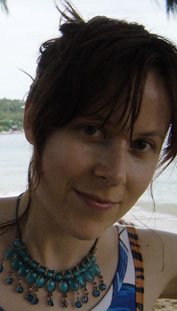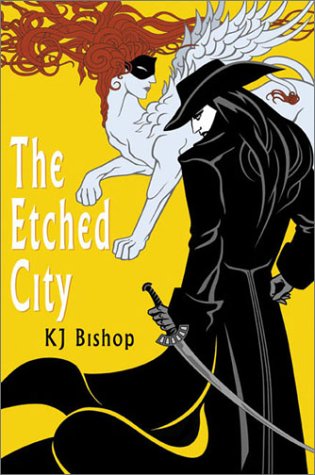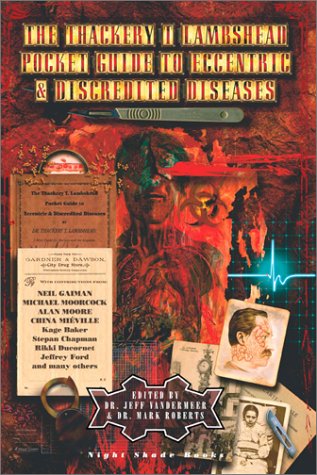Australian Horror
INTERVIEWS
KJ Bishop
ARTICLES
Finding Carnacki the Ghost Finder
OUR BOOKS
INFORMATION
REVIEWS
809 Jacob Street, by Marty Young
After The Bloodwood Staff, by Laura E. Goodin
The Art of Effective Dreaming, by Gillian Polack
Bad Blood, by Gary Kemble
Black City, by Christian Read
The Black Crusade, by Richard Harland
The Body Horror Book, by C. J. Fitzpatrick
Clowns at Midnight, by Terry Dowling
Dead City, by Christian D. Read
Dead Europe, by Christos Tsiolkas
Devouring Dark, by Alan Baxter
The Dreaming, by Queenie Chan
Fragments of a Broken Land: Valarl Undead, by Robert Hood
Full Moon Rising, by Keri Arthur
Gothic Hospital, by Gary Crew
The Grief Hole, by Kaaron Warren
Grimoire, by Kim Wilkins
Hollow House, by Greg Chapman
My Sister Rosa, by Justine Larbalestier
Path of Night, by Dirk Flinthart
The Last Days, by Andrew Masterson
Lotus Blue, by Cat Sparks
Love Cries, by Peter Blazey, etc (ed)
Netherkind, by Greg Chapman
Nil-Pray, by Christian Read
The Opposite of Life, by Narrelle M. Harris
The Road, by Catherine Jinks
Perfections, by Kirstyn McDermott
Sabriel, by Garth Nix
Salvage, by Jason Nahrung
The Scarlet Rider, by Lucy Sussex
Skin Deep, by Gary Kemble
Snake City, by Christian D. Read
The Tax Inspector, by Peter Carey
Tide of Stone, by Kaaron Warren
The Time of the Ghosts, by Gillian Polack
Vampire Cities, by D'Ettut
While I Live, by John Marsden
The Year of the Fruitcake, by Gillian Polack
2007 A Night of Horror Film Festival
OTHER HORROR PAGES
Arch Bishop
An interview with K. J. Bishop
By David Carroll and Kyla Ward, 2004
 Last year saw the release of The Etched City, an extraordinary novel of slippery reality, vivid atrocity and casual brilliance. It has since won its author—the Melbourne based Kirsten Bishop—widespread acclaim and awards, and has now been taken up by mainstream publishers after its original, independent, publication.
Last year saw the release of The Etched City, an extraordinary novel of slippery reality, vivid atrocity and casual brilliance. It has since won its author—the Melbourne based Kirsten Bishop—widespread acclaim and awards, and has now been taken up by mainstream publishers after its original, independent, publication.
But though it is this first novel that is causing the stir, the attentive will have also seen Kirsten's name attached to a string of stories in Australian and overseas markets, going back seven years or so. These have been distinctive tales of talking tigers, defecating angels, and the further adventures of 19th century murderer and shapeshifter Maldoror (perhaps the stand-out story in Jeff VanderMeer's Album Zutique, along with some strange sunsets).
Corresponding from a number of exotic locations, here Kirsten talks about magic, inspiration and what might be coming next.
Tabula Rasa: What makes a K J Bishop?
KJ Bishop: Well, I was K J Priest, but they promoted me. Look out for K J Pope in the future.
TR: You have been cited the French decadents as an influence. Could you live back in 19th Century France, do you think?
KJB: If we're talking late 19th Century Paris, I like to think I could have lived there and had a ball. I mightn't have lived long, but hopefully I'd have had a good old time before the absinthe or the syphilis killed me.
TR: The other influence you've given for The Etched City is Westerns — a much starker literature. How do the two meet up?
KJB: In an opium den in a godforsaken town, most likely. Both the Decadent and the Western belong to the latter half of the nineteenth century, so you've got the same technology and decor around the characters. In the gunslinger and/or gambling man, you've got a counterpart to the dandy — the two are linked through individualism and showmanship, pride, a rejection of ordinary life, and discipline: the gunslinger with his skills, the dandy with his personal presentation. A figure like Doc Holliday combines both worlds. And the Wild West had its adventuresses and grisettes just like Europe. The meeting of the actual literature isn't too difficult, either. Certainly the Decadent is more ornamental, but the Western is as concerned with style in its own way, and it's possible to combine the two. Both literatures tend to concern themselves with extreme behaviours and with characters who are adrift from 'normal' marriage, family and jobs. Where I think they significantly diverge is in the Decadent concern with artificiality versus the Western concern with actuality; the approach to the question of identity is quite different. In the Western, the characters are defined by their actions; in Decadent literature, they are (it seems to me) what they think or dream or pretend; identities tend to be fragmented — which leads to different ideas about self-worth, honour, morality, accountability. But in a novel there's room to look at both sides of that; it easily becomes a dialogue. Michael Moorcock made the Western and the Decadent work brilliantly together in Blood, which is probably where I got the idea from!
TR: The Etched City has made a celebrated passage from small press to mainstream publication. What were the advantages and disadvantages of this route? Do you think it will become more common?
 The Etched City (Prime edition), cover by KJ Bishop |
I don't know if it will become more common — I'd have to be quite a competent crystal gazer to answer that! It may depend on how well the present crop of indie press recruits fares in the marketplace.
TR: What can you tell us about the foundation of Ashamoil?
KJB: Damp, shaky, termite-ridden! Ashamoil is essentially a movie set. There's nothing more there than what you see in the book. I don't know anything about its history or politics, other than that it's a city-state, governed by some sort of city council. Physically, it's suburbia writ large, with little bits from India and Africa to give it a colonial feel. The river in the city is called the Skamander, after the river in the Iliad, which becomes choked with corpses and tries to kill Achilles, who bears the largest responsibility for the corpse situation. The idea is supposed to be that the world in the book isn't really a self-contained secondary world; it's a collage of elements from the reality and the fiction of our own world. Which isn't supposed to make it seem unreal or parodic so much as imitative of our own reality as I see it, which is as a collage of myths and stories.
TR: There was magic abroad in the city, but it seemed wilder than most fantasies. Can we ask if Beth was a controlling force, or being swept along with everyone else?
KJB: I think the reading of Beth as a controlling force is valid, but there are other equally valid readings. I intentionally left it ambiguous. It was important to me that other ideas, such as the Rev's view of a world with an active deity (not Beth!) in it, be given plausibility in the story.
TR: Did you do any specific research for the novel?
KJB: A bit. I tried to find out a few basic things about guns, how fast and far camels can run, practical things like that. I researched birth deformities for Raule's collection. But it was a very personal book for me. It came out of things in my life and ideas that I was familiar with and interested in.
TR: Gwynn has appeared before in your short stories. Will he be back?
KJB: It's tempting to bring him back, because I'm very fond of him. But against that, at the moment I feel as though I told the most important part of his story in Etched City. And because he doesn't really change — whatever happens to him, he's never going to turn into Mr Nice Guy — there are limits to the stories I can tell with him and still remain true to his character.
I can imagine bringing him back when he and I are both much older. But you never know what will happen.
 Kirsten Bishop on the range in Vienna |
KJB: Not a correction, no. It's more like a fanfic, really! What happened was that I got quite sick with sinusitis, and was so busy (I had two jobs at the time, and other things were happening) that I didn't have time to go to the doctor for antibiotics. So I just kept taking Sudafed, for weeks. Therefore I wasn't sleeping, and I was still sick. 'Maldoror Abroad' came out of that. The voice in the story just started talking to me. I don't know which version you've read. The Australian one is 3000 words shorter than the American one, and I prefer the longer version. I wrote a lot more, but it didn't all end up in the story (either one). Some bits went into Etched City, which I was still rewriting. I don't think my Maldoror is exactly the same guy as Lautreamont's; he's just my riff on that character.
TR: 'Beach Rubble' was an SF story — do you see it as being a different sort of story from your other work?
KJB: Not really. Yes, it's set in our world, but it's virtual reality, which to me is another term for fantasy. VR (in the advanced form it has attained in the story) is just shared imagination. It's like being able to consciously inhabit your own and other people's daydreams; it's all about the inner life, the life of the mind. VR has a connection with the Decadents, too, in the idea of a constructed, artificial, aesthetic world. Huysmans' character Des Esseintes from 'A Rebours' would have loved VR. There's a scene where he plans a holiday to England but only gets as far as an English-style pub, which contains all the elements of Englishness as he imagines it. He decides not to go to England itself, guessing — probably correctly — that he'll be disappointed in the reality.
TR: All your writing shares a very rich linguistical style, and you also work as a graphical artist. Can you bring the sensibilities of one form to the other?
KJB: Yes, sure. In a basic way, studying art, being a fan of pictures, gives you an inner image library. There's a danger, though, of getting so enthusiastic about the image that you forget about the importance of the words, and end up describing some wonderful sight in bland language. I try not to do that, but I'm sure I've been guilty of it. But that's where the sensibility comes in. You have to think, how can I translate that visual beauty, exuberance, melancholy or whatever it is into a linguistic equivalent. With writing, of course, you're always approximating something; when you write a description, every reader will form a different mental picture from your words.
In terms of structuring a narrative, or parts of a narrative, you can use visual models. I've only tried to do that once so far, in a story called 'We the Enclosed', in Leviathan 4, which is coming out in December. The story starts off in a claustrophobic space and moves into progressibly larger and more complicated spaces. I was reading some Proust recently and I noticed a flower-like structure, where he starts at one point, goes out, comes back, goes out, and so on. Colour's another thing. It can be symbolic, atmospheric, or used to draw attention to connections between things in a story. I haven't explored the possibilities of colour very much yet. It would be interesting to write a book with a particular palette of colours; not using them exclusively, necessarily, but emphasising them.
 The Thackery T. Lambshead Pocket Guide to Eccentric and Discredited Diseases, including a contribution by KJ Bishop |
KJB: I'm a bit wary of the label. Labels tend to turn into marketing terms. And weird fiction is published constantly, so the 'New' seems a bit suspect. That said, Jon Courtenay Grimwood when asked about the New Weird at the recent Commonwealth of Science Fiction conference in Liverpool made a good point when he described NW as a sensibility that has to do with borrowing. I was reminded of something David Bowie said about his method of merging high and low art in his work. New Weird seems to do a fair bit of that. Collage and bricolage.
TR: You apparently had a site dedicated to obscure authors. Are there any in particular you think should be better known at the moment?
KJB: I don't have the website anymore. It began as a way to make publicly available the work of William Sharp, who also wrote as Fiona Macleod. He wrote a large body of work, mostly concerning nature and folklore. It's beautiful stuff, and full of tales that he gathered from people in isolated places around and about Scotland. There's a site with a lot of his work online: Sundown Shores.
There are a lot of writers who should be better known. Geoff Maloney, Catherynne M. Valente and Zoran Zivkovic spring to mind as three who ought to have a wider readership, though I could name dozens. Many are writers principally of short stories. And there are all the dead writers who were great and don't get read much anymore. At the moment I'm reading a wonderful fantasy, The Crock of Gold, by James Stephens, and The Good Soldier by Ford Madox Ford. Both very fine books.
TR: Is Thackery T. Lambshead just a dirty old man?
KJB: That's like asking was Elvis just a singer.
TR: Are there any new projects in the works we can look forward to?
KJB: I'm scribbling away at one or two things.
TR: Will you continue to write short stories, do you think?
KJB: I don't know about short stories. I don't seem to enjoy writing them that much, but I can get enthusiastic if they invite you to do it and there's a cool topic, like with The Alsiso Project, where the theme was the nonexistent word 'alsiso'. Black Dog is the current novel I'm working on, but it may be overtaken by another book, which is a fantasy with a fairytale / folktale quality.
TR: Well, we hope you enjoy the rest of your holiday first. Thanks for your time.
©2020 Go to top

